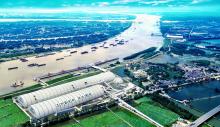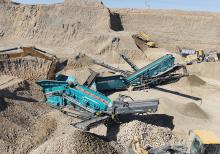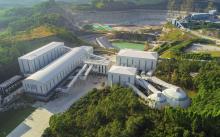As president of the China Aggregates Association Hu Youyi has a wide-ranging remit. He spoke to Liam McLoughlin about his work on the new quarrying environmental standards being introduced in the country, and helping Chinese companies expand into potentially huge international markets.
China consumes around 50% - nearly 20 billion tonnes - of the world’s annual aggregates output. This startling statistic means that being president of the China Aggregates Association (CAA) is a very influential office to hold.
Established in 1981, the CAA was approved by the Ministry of Civil Affairs to act as the Chinese aggregates industry’s national non-profit “social” group in 1992.
The current CAA president, Hu Youyi, is a professor of engineering with an impressive background in the aggregates sector. He has been engaged for many years in research on aggregates and solid waste utilisation, and in scientific technology management work for the building materials industry. He is currently working on standards, regulation, technology innovation and green development in the aggregates industry.
The CAA is at the centre of Chinese efforts to move further to the forefront of the global aggregates sector. China’s massive Belt and Road Initiative to carry out infrastructure projects along a new Silk Road trade route provides a huge market for the country’s aggregates players.
“This is a good opportunity for us to go global,” says Hu. “One hundred and twenty-four countries have already joined the initiative and they are mostly poor and developing nations. They need lots of roads and building construction, so we think it brings a lot of opportunity for aggregates companies and machinery manufacturers to develop their global strategy. Aggregates companies can work together with local government and companies to provide the aggregates.”
There are 3,000 aggregates equipment manufacturing companies in China.
“A lot of European and American companies come over to China, including
One example of a Chinese company cooperating with a foreign firm is Shanghai-based crushing and screening equipment manufacturer Shanghai
In terms of quality and price combined Hu believes that Chinese machines are superior to EU products, but he adds that Chinese manufacturers are still at the development stage in trying to achieve higher standards.
“There are a lot of good Chinese machinery manufacturing companies and they have already started their journey to go abroad,” he adds. “At the
The world’s annual aggregates production is about 40 billion tonnes, and it is estimated that this amount will reach 60 billion tonnes by 2050. The fact that China currently consumes half of global production makes the country pivotal to efforts to have a more environmentally-friendly extraction process.
“Stone quarries are the second-largest resource for humans to extract and use: the largest resource is water,” Hu says. “This will cause environmental problems across the globe. The current situation is not satisfactory and we need to have an integrated approach to the problem.”
Authorities are paying increased attention to the extractive methods in the Chinese aggregates sector, and industry development is being addressed at the highest level by the State Council - the chief administrative authority in China.
The central government has started to introduce new environmental standards, which are impacting the industry.
In April the State Council ordered the closure of 1,000 non-coal mines and quarries. The State Council discussed aggregates development at its conference meeting in June 2019. The coastal province of Hebei in northern China will shut down half of its non-coal mines and quarries by 2025.
In October 2015 the Chinese Senate passed the new Quarries Act relating to the organisation of the aggregates industry.
“In 2018 President Xi said we need to protect our water,” Hu said. “The same year we also had the construction specifications [from the Ministry of Natural Resources] for green mines in the aggregates industry, which is the first guidance for the sector.”
In September 2018 the CAA issued a letter with suggestions of safeguards for aggregates provision, and for a standardised process, and many local governments have adopted its recommendations.
Those involved in quarry production now have to simultaneously complete re-habitation of the site, according to Hu.
“Aggregate businesses are carrying out monitoring and they upload to the cloud so the government and environmental agencies can check that they are maintaining environmental standards,” he says.
To protect the environment Hu states that many aggregates companies are adhering to a higher standard than the government requires.
Greater controls have also been placed on the direct extraction of natural sandstone from the country’s rivers and mountains.
“2018 was a difficult year for companies doing mineral extractions on rivers,” Hu says. “There is a higher requirement on emissions.”
The demand for building materials generated by China’s rapid urbanisation has led to a shortage of aggregates such as river sand in key cities such as Shanghai.
Over the past 40 years of reform and opening-up in China, the urbanisation rate has increased from 17.92% in 1978 to 59.58% in 2018. During this period, a huge amount of infrastructure (including buildings, roads and bridges) has been built, and a large quantity of natural sandstone resources has been consumed. Hu says that the existing river sand reserves can no longer meet the demand for construction raw materials, and that the use of manufactured aggregates is widespread.
While the shortage of river sand has impacted China’s infrastructure construction in the short term, Hu says it has also promoted the rapid development of the country’s manufactured aggregates industry.
“The use of manufactured aggregates has become the development direction of the aggregates sector,” he adds. “China’s aggregate industry standard will guide and standardise the development of the industry, improve the performance of manufactured aggregates products, and promote the green and high-quality development of manufactured aggregates.”
He says that using tailings and waste rock to make manufactured aggregates will be an important part of the relevant standards for the aggregates sector.
The recent explosive growth in urban rail transport construction (35 railway projects were started in 2018) has also increased the demand for aggregates. The CAA is now collecting data for which sector uses the most aggregates and it has calculated that, for each 1km of standard railway, 16,000 tonnes of aggregates is used. For high-speed railways the figure is 60,000 to 80,000 tonnes of aggregates per 1km.
“For a long time we only cared about economic development and not the environment,” Hu says. “When we mine in an area we also need to benefit that area. We need to earn our profit with clean water and beautiful mountains.”
The CAA is increasing its focus on the use of new technologies such as 5G (fifth generation) cellular networks to drive development of the aggregates sector. Hu says that if 5G gains traction in the industry it will be a major breakthrough due to its high speed and lower latency (faster transmission times for packets of data). He says that the use of 5G would improve the balance of equipment such as robots and trucks in smart quarries and mines.
The CAA has several R&D departments exploring the use of new technologies. One is developing a cloud platform for designing stone mines and has devised a visual simulation of how aggregates would be transported in this situation. The Chinese telecom company Huawei is already using 5G technology to remotely control equipment in the mining sector. The company claims 5G boosts safety and efficiency in addition to saving the industry US$150,000 a year per driver.
Hu says that the emphasis in the now is moving away from changes in industrial structure and is now based on new technology and integrated development. “Everything should be connected in the quarrying industry,” he says. “We need to build a community of shared future.”








